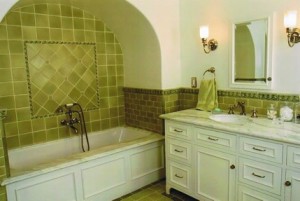5 Must-Use Spots for Trim Tile
Trim tile is essential for providing an attractive finished look to fields of tile.
 If you are planning a project involving wall tile, you almost certainly need to order some trim tiles as well. Trim tile comes in a variety of shapes and designs suitable for different needs, from thin pencil tiles to bold molding tiles. Here are 5 situations where you will probably want trim tile.
If you are planning a project involving wall tile, you almost certainly need to order some trim tiles as well. Trim tile comes in a variety of shapes and designs suitable for different needs, from thin pencil tiles to bold molding tiles. Here are 5 situations where you will probably want trim tile.
Edges
The most important spot to use a trim tile is at the exposed edges of any tile surface. This need often appears when you are running tile only partway up a wall. It would not really do to simply end the tile when you reach the desired height, as with many tile shapes this would leave an unfinished ceramic edge exposed at the top. A specially designed trim tile will not only cover up this edge, but also add an appealing finishing touch to the tile design.
Corners
Of course, trim tiles are not just for the top edges. They can also be used for vertical edges or seams that are created with tiles run past a corner on a wall. Covering the seam with a specially designed trim tile just makes the whole installation look more attractive. The trim tiles for inside corners are called cove tiles and those for outside corners are called edge tiles.
Transitions
Often, tile designs call for different types, colors, shapes, or patterns of tile to be used on a single surface. One common example is a mosaic or mural inset over the range in the kitchen or over the tub in a bathroom. In this case, a decorative rope or braid trim tile—or some other type of appealing trim tile—can be used as a transition between the different tiled fields.
Accents
Trim tiles can also be very useful for breaking up really large expanses of wall tile that could otherwise look boring. Depending on your design, you might opt for a simple piece of pencil trim in a contrasting color, or a more dimensional molding trim that would mimic the look of a crown molding at the ceiling or the look of a chair rail molding midway up the wall.
Dimensional Changes
One final situation where you would really need a trim tile is if you are using an especially thick tile such as a concrete tile on your walls. Of course concrete tile is primarily considered floor tile, but designers are increasingly experimenting with it on walls to take advantage of its bold colors and patterns. Rather than leave a thick lip of tile exposed, it might be advisable to use some kind of trim—whether ceramic tile or wood—to hide the dimensional change.
If you would like assistance planning your tile design, please do not hesitate to contact Mission Tile West.
